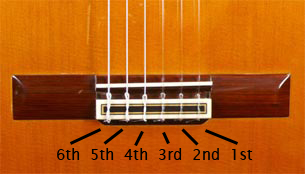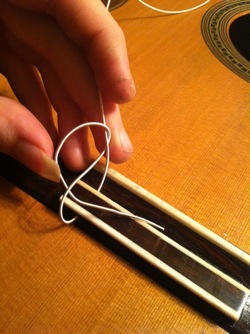How to Change Classical Guitar Strings
If you play classical guitar, you should change your strings regularly. New strings make your guitar sound loud and resonant.
Here, I will give you step-by-step instructions to change your classical guitar strings.
Instructions
Step 1: Take off Your Old Strings
Hold the guitar facing away from you. Turn the tuning pegs clockwise until the strings are completely loose (I recommend using a string winder to do this). Untie the strings from both ends and throw them away. Try to remember how each string looks when you untie them so that you remember when you put them back on.
Step 2: Tie a New String to the Bridge
Put the guitar flat on the ground, with the soundboard facing up, and the neck pointing away from you.
For most guitars, there are 6 wholes in the bridge--the 1st string goes in the rightmost hole, followed by the 2nd string, 3rd string, etc.

Choose a string, and slip about 3 inches of that string through its hole in the bridge.

Then, pull the end over the bridge and wrap it around the left side of the string.

Once you do this, wrap it around, and underneath itself, like the picture below:

Pull the end of the string to tighten it, then wrap it 1-2 more times. When you finish, it will look like a coil:

Pull the long end of the string to tighten it against the bridge. When you finish, it will look like this:

Changing strings is always difficult the first time, so don't worry if it doesn't look perfect. Just keep practicing!
Step 3: Wrap the String around the Tuning Peg
The picture below shows you which string goes to which tuning peg:

Turn the tuning peg so that the hole is facing towards you. Take the end of your string and slip it a few inches through its tuning peg hole.

Grab the end, pull it up over the tuning peg, then around and under the left side of the string:

Pull the slack out of the string, and put your finger on it so it does not slip.

Step 4: Wind the Tuning Peg Until it Reaches the Right Pitch
As you hold the end of the string, turn the tuning peg counterclockwise (with the guitar facing away from you). As you turn the tuning peg, make sure the string wraps over the loose end to secure it in place. Once the string builds some tension, you can take your finger off, and it will hold in place on its own:

Continue turning the tuning peg until the string is at the right pitch. Use a guitar tuner to help you with this. Guitar tuning is E - A - D - G - B - E.
Step 5: Repeat for Every New String
Do the same thing for the rest of the strings. Once you change all of the strings, you can trim the loose ends of the strings with a pair of wire cutters so that it looks clean and professional.
How Often Should You Change Strings?
You should change your strings whenever they start to sound dull and quiet.
How long will this take? It depends on the person. Based on how much you play and how oily your skin is, your strings may last anywhere from 2 weeks to 6 months.
Also, treble strings tend to last a lot longer than bass strings. Personally, I change my basses about twice as often as my trebles.
Experiment, and find what works best for you!
Copyright 2014 © ClassicalGuitar101.org | All Rights Reserved
Popular Articles:
Making a Living as a classical guitarist
List of Classical Guitar Competitions
About Me
My name is Daniel Nelson, and I am a classical guitar teacher and performer from Los Angeles, California. Click here to learn more.
Leave a Comment!